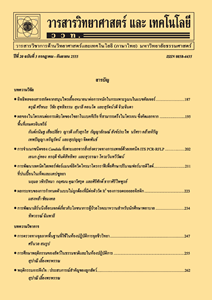การประเมินประสิทธิภาพการกรองของวัสดุผ้าทั่วไปกับอนุภาคขนาด 0.3 ไมครอน
Main Article Content
บทคัดย่อ
ปัญหาการขาดแคลนหน้ากากอนามัยแบบใช้แล้วทิ้งในช่วงที่โควิด 19 ระบาดในประเทศไทย บางคนอาจต้องการใช้วัสดุผ้าทั่วไปในการป้องกันระบบทางเดินหายใจ เนื่องจากปัญหาการขาดแคลนหรือความสามารถในการจ่าย วัตถุประสงค์ของงานนี้ คือ เพื่อศึกษาเชิงทดลองประสิทธิภาพการกรองของวัสดุผ้าทั่วไปกับอนุภาคขนาด 0.3 µm งานนี้ดำเนินการโดยวิธีการทดสอบมาตรฐาน ASTM F2299-03 เพื่อหาประสิทธิภาพการกรองและการทะลุผ่านของวัสดุผ้าด้วยการใช้อนุภาคทรงกลมชนิดพอลิสไตรีนลาเท็กซ์ การศึกษานี้ได้ทดสอบวัสดุผ้า 5 ประเภทหลัก ได้แก่ ผ้าไมโครไฟเบอร์ ผ้าคอตตอน ผ้าฝ้ายทอมือ ผ้านาโน และผ้าโพลีเอสเตอร์กับอนุภาคขนาดเส้นผ่านศูนย์กลางประมาณ 0.3 µm ที่ความเร็วด้านหน้าประมาณ 10.6 cm/s และเปรียบเทียบกับระดับการทะลุผ่านของวัสดุกรองหน้ากาก N95 ผลการศึกษาพบว่าวัสดุผ้าที่ทดสอบในการศึกษานี้มีประสิทธิภาพในการกรองอนุภาค 0.3 µm อยู่ในช่วง 9-36 % ระดับการทะลุผ่านอนุภาคขนาด 0.3 µm ของวัสดุผ้าเหล่านี้สูงกว่าการทะลุผ่านของวัสดุกรองหน้ากาก N95 มาก ผลที่ได้จากการศึกษาแสดงให้เห็นว่าวัสดุผ้าทั่วไปอาจให้การป้องกันอนุภาคซับไมครอนและฝุ่น PM2.5 ได้เพียงเล็กน้อย
Article Details
References
Department of Disease Control, COVID-19 Situation Report, Available Source: https://covid19.ddc.moph.go.th, October 24, 2020. (in Thai)
Thepnuan, D., Yabueng, N., Chantara, S., Prapamontol, T. and Tsai, Y.I., 2020, Simultaneous determination of carcinogenic PAHs and levoglucosan bound to PM2.5 for assessment of health risk and pollution sources during a smoke haze period, Chemosphere 257: 127154.
Fushimi, A., Hasegawa, S., Takahashi, K., Fujitani, Y., Tanabe, K. and Kobayashi, S., 2008, Atmospheric fate of nuclei-mode particles estimated from the number concentrations and chemical composition of particles measured at roadside and background sites, Atmos. Environ. 42: 949-459.
Intra, P. and Siri-achawawath, T., 2019, Development of an online particulate monitoring system for measurement of the mass and number concentrations and size distributions of ambient PM10, PM2.5 and sub-400 nm particles, Songklanakarin J. Sci. Technol. 41: 1339-1347.
Srivastava, A., 2021, COVID-19 and air pollution and meteorology – An intricate relationship: A review, Chemosphere 263: 128297.
Leiva, G.M.A., Santibañez, D.A., Ibarra, S., Matus, P. and Seguel, R., 2013, A five-year study of particulate matter (PM2.5) and cerebrovascular diseases, Environ. Pollut. 181: 1-6.
O’Dowd, K., Nair, K.M., Forouzandeh, P., Mathew, S., Grant, J., Moran, R., Bartlett, J., Bird, J. and Pillai, S.C., 2020, Face masks and respirators in the fight against the COVID-19 pandemic: A review of current materials, advances and future perspectives, Materials 13: 3363.
El-Atab, N., Qaiser, N., Badghaish, H., Shaikh, S.F. and Hussain, M.M., 202, Flexible nanoporous template for the design and development of reusable anti-COVID-19 hydrophobic face masks, ACS Nano 14: 7659-7665.
Sickbert-Bennett E.E., Samet J.M., Clapp, P.W., Tong, H., Weber, D.J. and Bennett, W.D., 2020, Filtration efficiency of hospital face mask alternatives available for use during the COVID-19 pandemic, JAMA Int. Med. 180: 1607-1612.
Konda, A., Prakash, A., Moss, G.A., Schmoldt, M., Grant, G.D. and Guha, S., 2020, Aerosol filtration efficiency of common fabrics used in respiratory cloth masks, ACS Nano 14: 6339-6347.
Aydin, O., Emon, B., Cheng, S., Hong, L., Chamorro, L.P., Saif, M.T.A., 2020, Performance of fabrics for home-made masks against the spread of COVID-19 through droplets: A quantitative mechanistic study, Extreme Mech. Lett. 40: 100924.
Rengasamy, S., Eimer, B. and Shaffer, R.E., 2010, Simple respiratory protection – Evaluation of the filtration performance of cloth masks and common fabric materials against 20-1,000 nm size particles, Ann. Occupat. Hyg. 54: 789-798.
Willeke, K. and Baron, P.A., 1993, Aerosol Measurement: Principles, Techniques, and Applications, John Wiley & Sons, New York, NY.
ASTM F2299/F2299M-03(2017), 2017, Standard Test Method for Determining the Initial Efficiency of Materials Used in Medical Face Masks to Penetration by Particulates Using Latex Spheres, ASTM International, West Conshohocken, PA.
Liu, B.Y.H. and Pui, D.Y.H., 1974, Equili brium bipolar charge distribution of aerosols, J. Colloid Interf. Sci. 49: 305-312.
Timko, M.T., Yu, Z., Kroll, J., Jayne, J.T., Worsnop, D.R., Miake-Lye, R.C., Onasch, T.B., Liscinsky, D., Kirchstetter, T.W., Destaillats, H., Holder, A.L., Smith, J.D. and Wilson, K.R., 2009, Sampling artifacts from conductive silicone tubing, Aerosol Sci. Technol. 43: 855-865.
Janssen, L.L., Anderson, N.J., Cassidy, P.E., Weber, R.A. and Nelson, T.J., 2005, Inter pretation of inhalation airflow measure ments for respirator Ddesign and testing, J. Int. Soc. Resp. Prot. 22: 122-141.
Reineking, A. and Porstendörfer, J., 1986, Measurements of particle loss functions in a differential mobility analyzer (TSI, Model 3071) for different flow rates, Aerosol Sci. Technol. 5: 483-486.
ASTM F2100-19e1, 2019, Standard Specifi cation for Performance of Materials Used in Medical Face Masks, ASTM Interna tional, West Conshohocken, PA.

